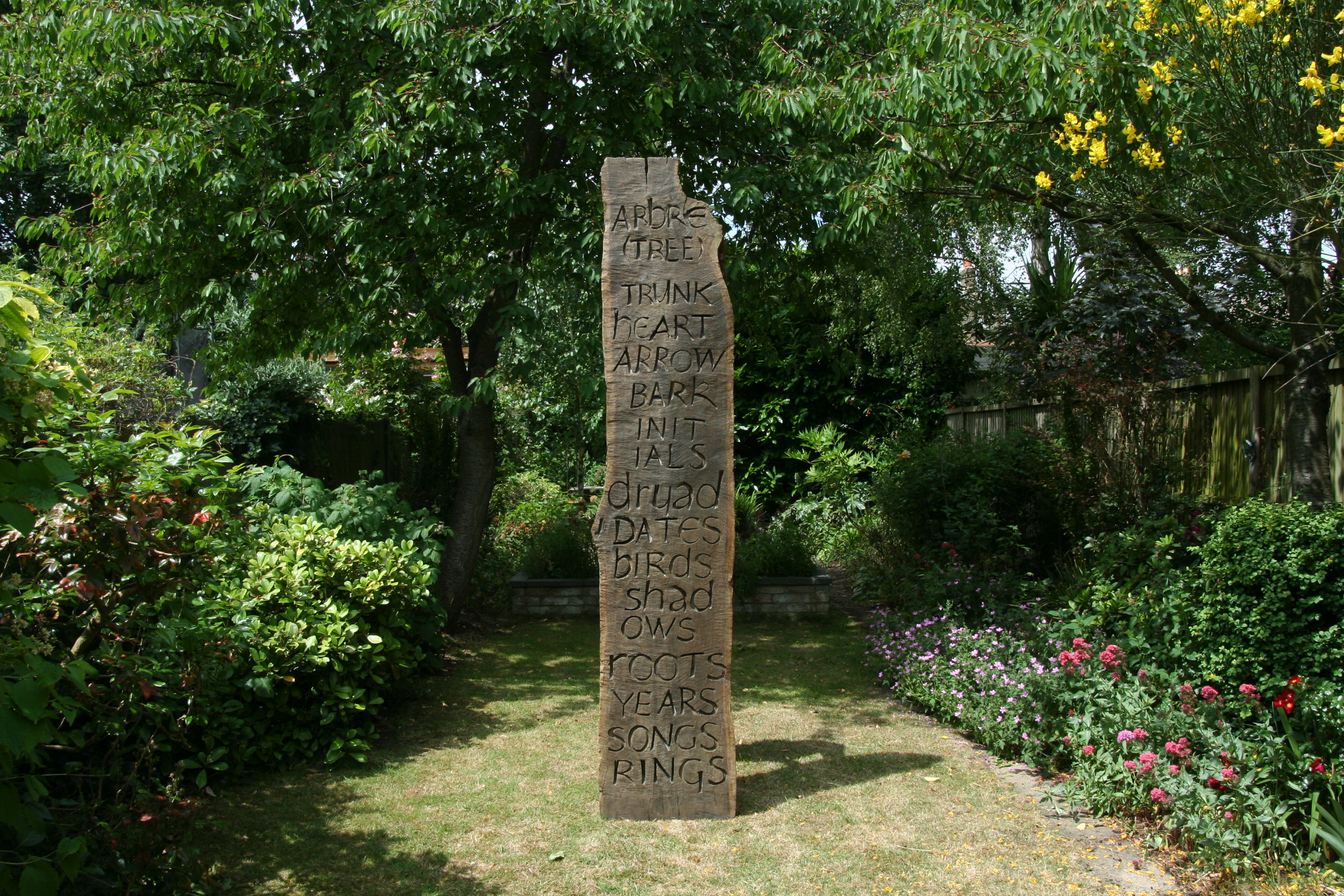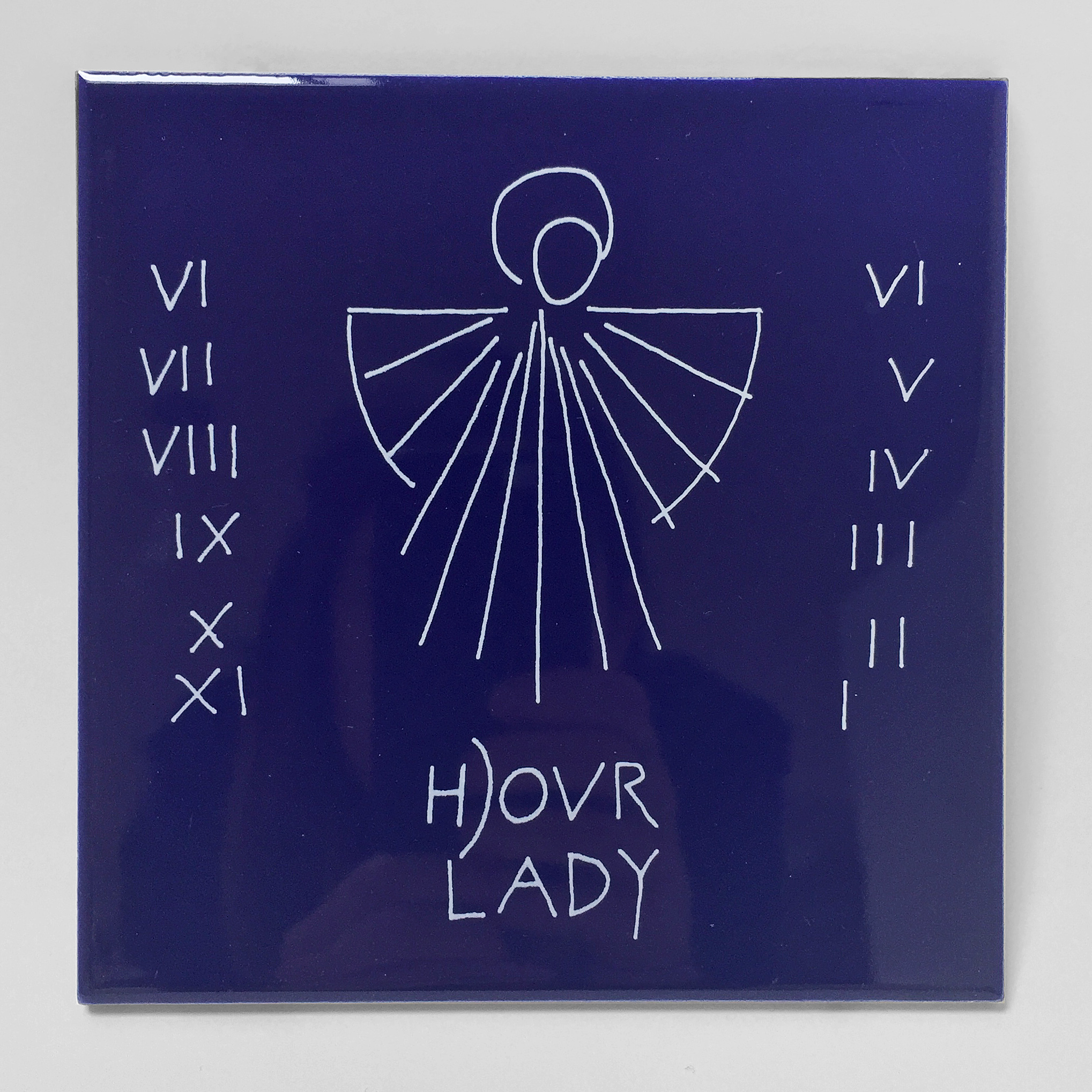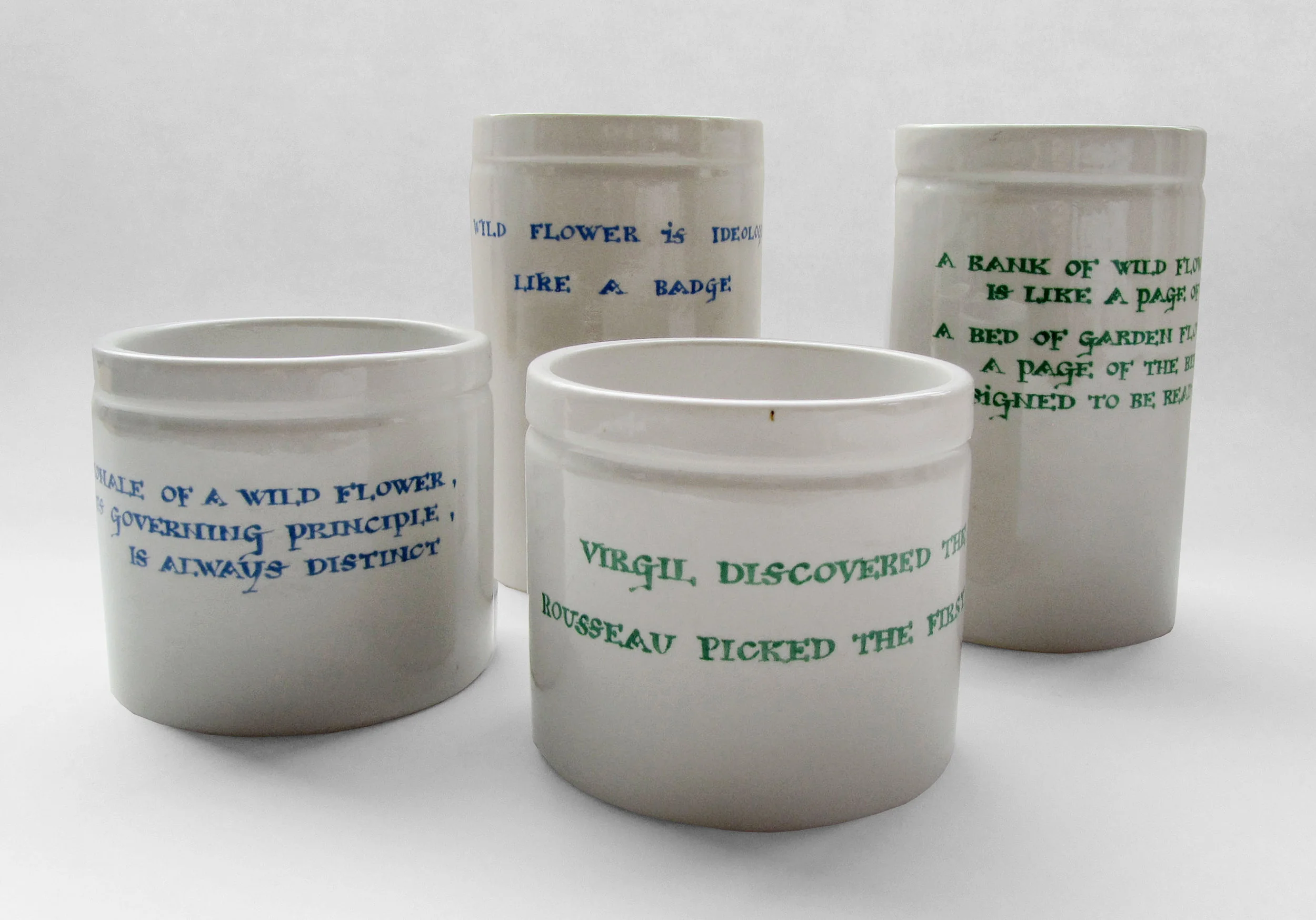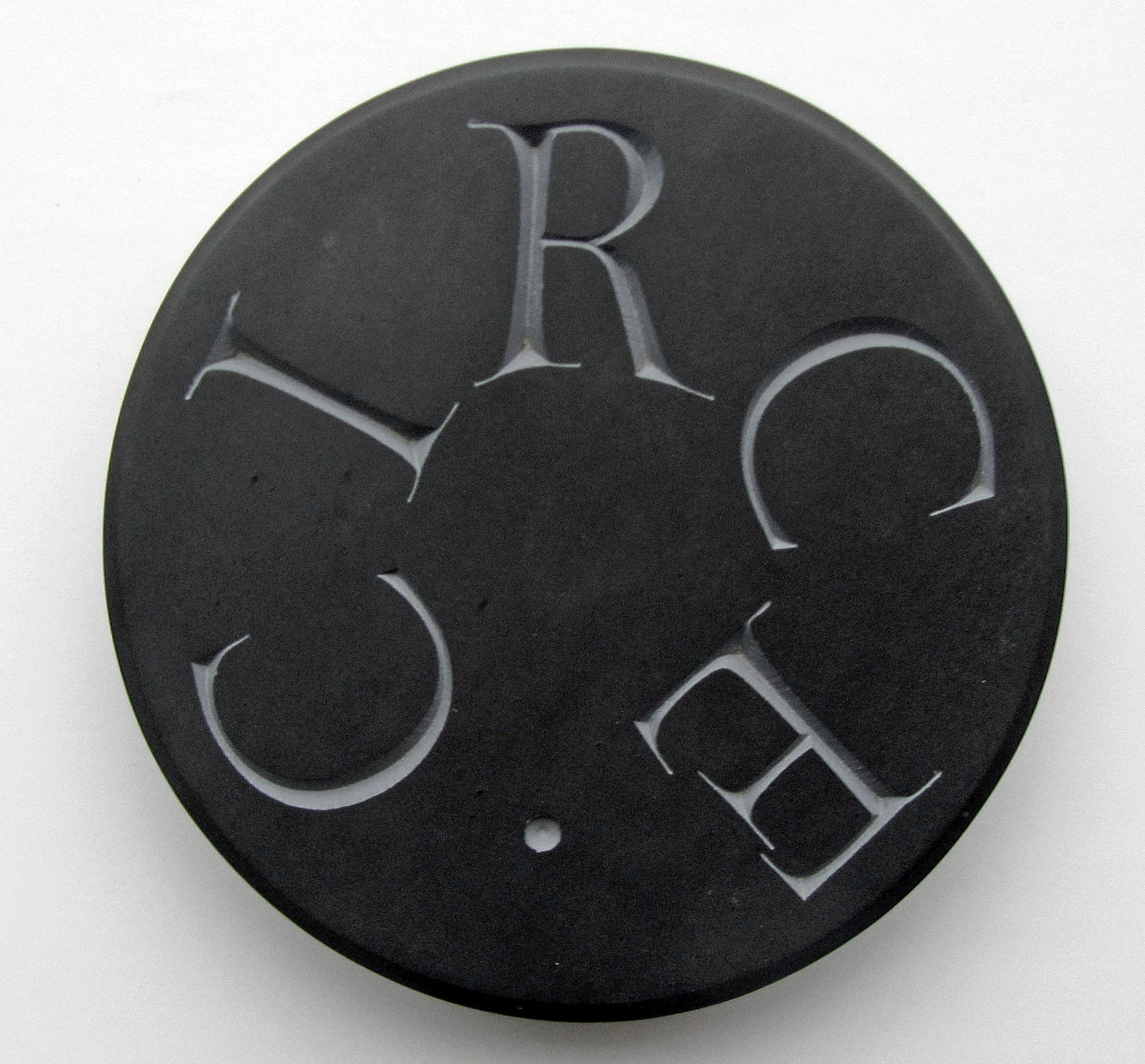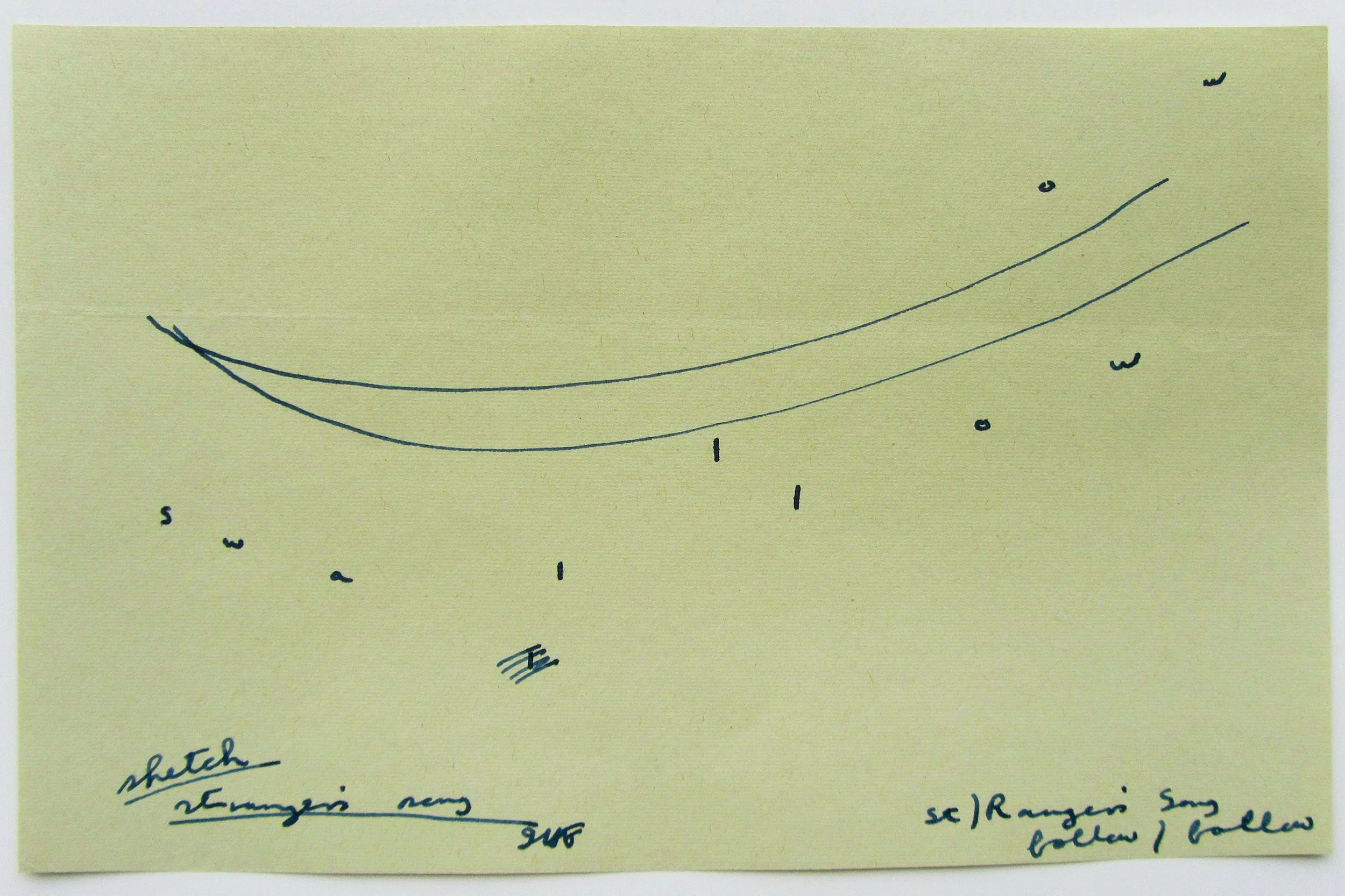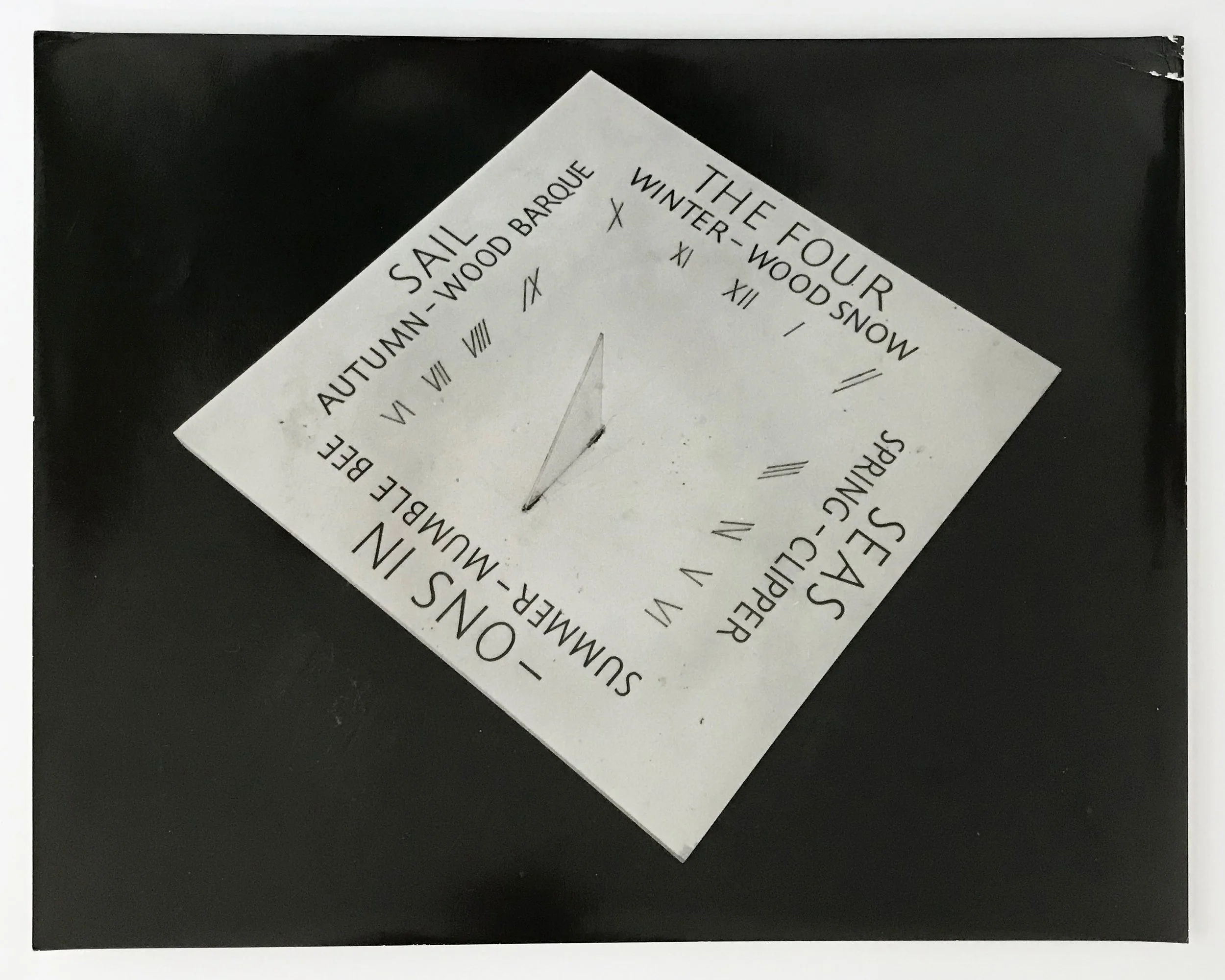Ian Hamilton Finlay
b. 1925 Nassau, The Bahamas d. 2006 Edinburgh
Arbre (Tree), 1976
Wooden sculpture, 2640 x 510 x 100mm
With carving by Michael Harvey
Exhibited in the grounds of the Serpentine Gallery as part of Finlay’s solo show in 1977. Arbre belonged to the Estate of Lesley Lendrum – one of Finlay’s closest friends and confidantes – and was installed in Lendrum’s garden up until her death in 2012.
Reproduced in Alec Finlay (ed.), Ian Hamilton Finlay: Selections (London: University of California Press, 2012), 45. In a black and white photograph, Sue Finlay is seen standing by the work outside the Serpentine, along with some of Finlay’s collaborators from the 1970s including John Andrew, Stephen Bann, Ron Costley, Andrew Dempsey, Michael Harvey and John Thorpe.
POR
Zephyr INS6, Shepherd Lad KY216 and Amaryllis BCK55, 1977
White ceramic tiles with hand-painted text, 150 x 150mm each
Exhibited as a group of three at Tate Britain and Tate St. Ives. Other tiles available on request.
Ref: Homage to Ian Hamilton Finlay (London: Victoria Miro, 1987), plate 13; and Ian Hamilton Finlay: Maritime Works (Cornwall: Tate St. Ives, 2002), p.41.
NFS
H)our Lady, c.1977
Blue and white ceramic tile, 180 x 180mm
With Ron Costley
£2,500
Wildflower Vases, 1992
White ceramic vases with hand-painted text, 137 x 85mm / 96 x 82mm
Unnumbered edition of 3 in these colours and sizes. £1,250 each
Exhibited at Victoria Miro, London (2003) and Sfeir-Semler, Hamburg (2004).
Texts read:
A WILDFLOWER IS IDEOLOGICAL
LIKE A BADGE
THE RATIONALE OF A WILDFLOWER,
ITS GOVERNING PRINCIPLE,
IS ALWAYS DISTINCT
VIRGIL DISCOVERED THE EVENING,
ROUSSEAU PICKED THE FIRST WILDFLOWER
A BANK OF WILDFLOWERS IS LIKE A PAGE OF THE BIBLE,
A BED OF GARDEN FLOWERS LIKE A PAGE OF THE BIBLE
DESIGNED TO BE READ AS LITERATURE
Bassin et Cruche, 1987
Ceramic jug and bowl with hand-painted additions, 350 x 257mm
Unnumbered edition of 2
With David Ballantyne
Exhibited at Fondation Cartier pour l’Art Contemporain, Paris (1987) and Victoria Miro, London (1990). Adapted from Finlay’s proposal L’Idylle des Cérises (1986), two versions were eventually made – one for the Paris exhibition and one for London.
Ref: Poursuites révolutionnaires (Fondation Cartier pour l’Art Contemporain, Paris, 1987), p.67
£8,000
COR / DAY / LUX, 1995
Portland stone, 450 x 350 x 80mm
With Andrew Whittle
Exhibited at Deichtorhallen, Hamburg (1995).
POA
Harvester / Gleaner, 2000
Slate with stone base, 307 x 383 x 52mm
With Caroline Webb
Front text reads ‘For Harvester read Gleaner’. Back text gives boat identification numbers for ‘Harvester’ and ‘Gleaner’, and reads ‘EU Erratum’. Harvester / Gleaner is a comment on European fishing policies, combining sea and land motifs visible across Finlay’s oeuvre. It was originally intended for the garden at Stonypath, but was bought directly from the artist before it was installed.
POA
Flotte de pêche, 1987
Etched glass with wooden base, 510 x 402mm
No edition size given (but thought to be between 3 and 5 made)
Exhibited at Claire Burrus, Paris (1987).
£8,500
WAVE, 1992
Etched glass with wooden base, 176 x 575 x 60mm
Unnumbered edition of 14
Wave was originally realised by Finlay in book form in 1969. Across both book and glass sculpture, the poem incorporates the repetition of the wave-like ‘transposition’ sign throughout the text.
NFS
Shadows Icon, 1988
Carved oak sundial with gnomon, 255 x 165 x 42mm (unfolded)
With Caroline Webb
£7,000
Telephone Jar, c.1982
Ceramic pot, 105 x 110 x 110mm
With Roger Bunn
Unique ceramic pot with a handle in the shape of an old-fashioned telephone set on the lid. Inscribed around the main vessel are a series of telephone code numbers with corresponding texts reading ‘Dial-an-Oracle / Dhelphoi. Dial-a-Mermaid / Copenhagen. Dial-a-Ruin / Rome. Dial-a-Windmill / Amsterdam. Dial-an-Old Frog / Osaka. Dial-a-Lake / Lucerne’. Both the artist’s name and the collaborator’s name are etched on the base.
Bought directly from the artist at Stonypath in 1983.
£4,000
Pierrot, 1978
Cast metal mounted on wooden block with etched metal plaque, 163 x 105mm
Unnumbered edition of 5
Sharing its name with the sad clown figure from French pantomime, Finlay’s Pierrot also evokes an aeroplane and a missile, in line with military themes visible across his oeuvre.
SOLD
Circe, 1997
Carved slate, ⌀ 100mm
With Andrew Daish
£4,500
Le Circus, 1964
Blue, red & black on white ground, 443 x 577mm
Murray 5.4.
Finlay's first concrete poetry poster and therefore the first published in the UK. Printed on extremely thin paper. Unusually, all the edges are in tact, overall an excellent fresh copy. The best copy we have seen.
SOLD
Stranger’s Song, 1964
Holographic ink manuscript on green paper, 134x209 mm
This work is hand-drawn by Ian Hamilton Finlay, with hand-written notes along the bottom edge. Though it is unpublished as a poem, the theme of the swallow as an anchor of clouds would later appear in Finlay's works. Signed.
SOLD
Ajar, 1967
Screenprint printed black on gold on fragile paper, 575 x 504 mm
Probably edition size 250 to 300. But due to the fragile nature of the printing process, where around 100 prints were damaged beyond repair when stored, thought to be less than 50 good copies in circulation. Condition: as ever this copy has the usual handling marks, but unusually there are no tears or serious deterioration to the surface.
SOLD
Four Seasons Sundial, 1969
Silver gelatin print with brown felt tip and photographer's rubber stamp to verso, 287x363 mm. Unknown edition. In collaboration with Ronald Gunn.
Finlay began using photography as a medium for his work in 1969. Gunn was one of two early Finlay photographers. Finlay recognised Gunn's talent as a photographer, a talent that was matched by the difficulty of working with him: lack of communication and tardiness were two of Finlay's gripes with Gunn. No more than three copies of this work are in known existence.
SOLD
Acrobats, Tarasque Press, 1966/68.
535 x 380 mm silkscreen print in 2 colours on white ground. Seminal concrete poetry print by Ian Hamilton Finlay. The rarest and most sought after of the three Tarasque Finlay Concrete Poetry prints that are often dated 1966 but in fact were released in 1968. Finlay suffered a heart attack in 1967 and asked Tarasque to handle the printing process of this print. Undated and unsigned as issued. No edition size given (250 copies printed). On many occasions we have been asked to explain what Concrete Poetry is at social events and we always cite this work with the spaced-out letters of the word ‘Acrobats’ in day-glow orange on a vibrant blue background that appear to spin like acrobats in space when viewed. It can also be read as a column of acrobats supporting each other. One of Finlay’s most successful Concrete Poems of the 1960s, this colour version in our view having more dynamism and spatial interaction than the black and white version in the Blue and the Brown Poems Calendar, 1968.
SOLD
For further information about these works, please phone:
+44 (0) 208 693 3871
+44 (0) 7946 856835
Or send us an email.
